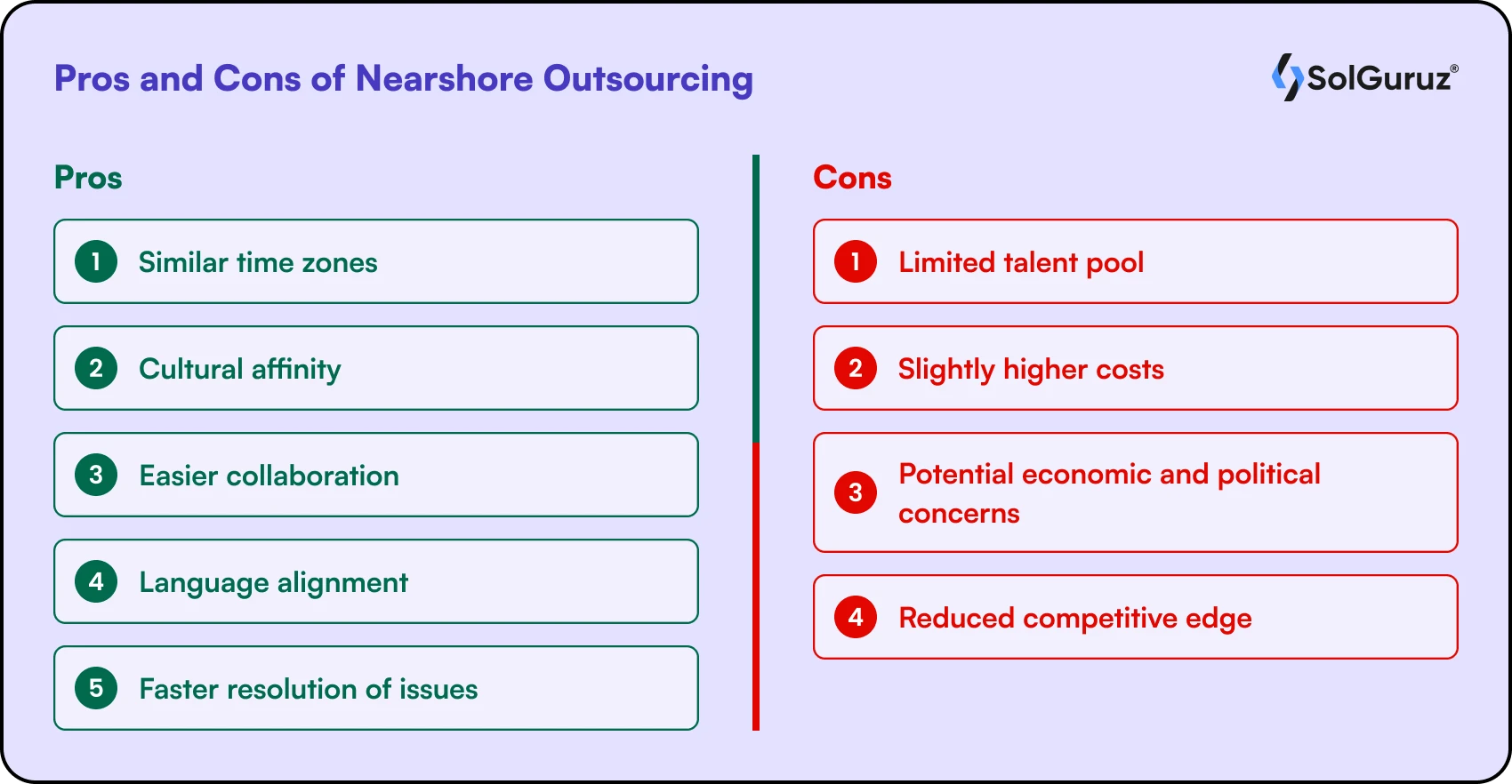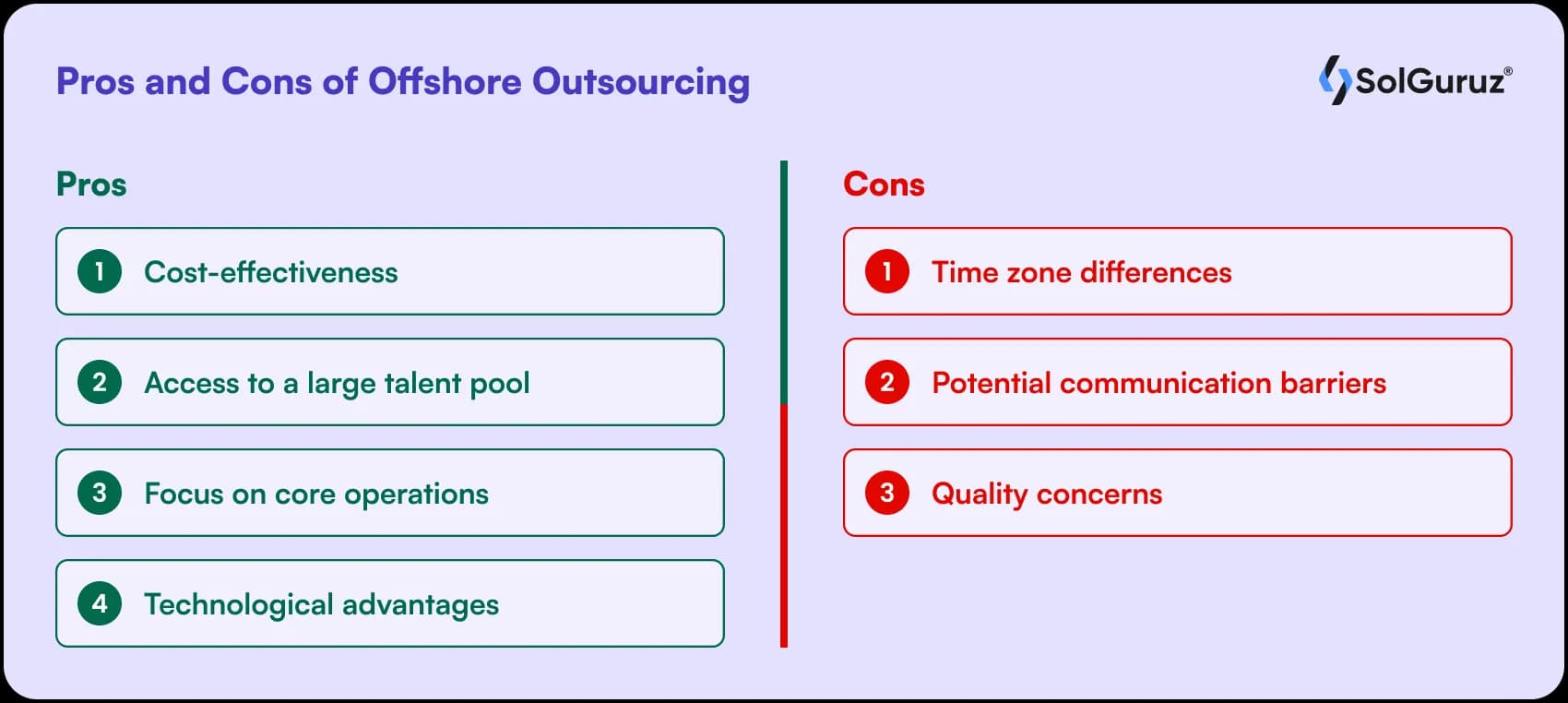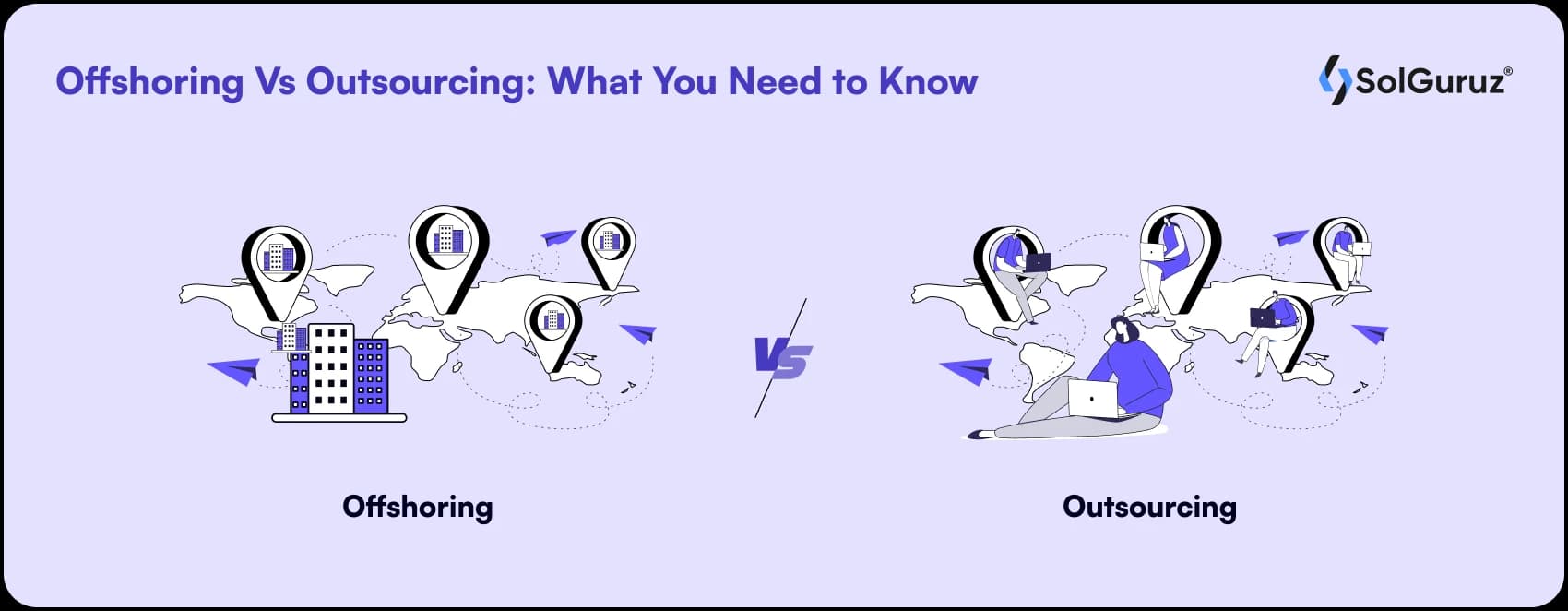Nearshore Vs Offshore Outsourcing: Choosing the Right Model
Explore the differences between nearshore vs offshore outsourcing. Consider the pros and cons of each model to identify the best fit.

Outsourcing has become a common practice for businesses looking to cut costs and expand their operations. In this blog, we will explore the differences between nearshore vs offshore outsourcing.
In 2021, the worldwide market for mobile app development stood at USD 197.2 billion. By 2030, the industry is projected to escalate to a remarkable USD 583.03 billion, with a consistent annual growth trajectory of 12.8% in 2022.
According to a study conducted by Bain, 60% of engineering executives intend to augment their outsourcing strategies in the coming three years. Furthermore, the same research indicates that expertise is the primary consideration when selecting a mobile app development outsourcing collaborator, surpassing cost.
In contrast, Software outsourcing firms account for a significant majority, exceeding 50% of the worldwide outsourcing market value. Projections state that the U.S. will amass roughly $44.35 billion in revenues from application outsourcing in 2023.
These trends underscore the increasing significance of both nearshore vs offshore outsourcing. The question is: Which models best suit your app development goals and operational needs? This article intends to arm you with the knowledge necessary to steer your app development project.Â
Table of Contents
Overview of Nearshore Outsourcing
Nearshore outsourcing involves delegating app development tasks to companies in neighboring countries or similar time zones. This strategy offers advantages for geographical and cultural alignment.Â
Unlike firms that outsource jobs to entities engaged in offshoring across continents, nearshoring usually means collaborating with firms in nearby countries. It fosters smoother collaboration due to fewer differences and barriers and allows companies to access a broad base of expertise that aligns with their environment.

Pros of Nearshore Outsourcing
With nearshoring mobile app development outsourcing, companies can often leverage the benefits that optimize both communication and collaboration:Â
- Similar time zones: Teams can synchronize their efforts in real-time to ensure that business hours overlap.
- Cultural affinity: A shared or similar culture can reduce misunderstandings and streamline communication processes.
- Easier collaboration: The feasibility of regular in-person meetings strengthens relationships and encourages teamwork.
- Language alignment: A shared language or high skill in a common language simplifies communication.
- Faster resolution of issues: Proximity allows swift responses to challenges. This ensures minimal disruptions.
Cons of Nearshore Outsourcing
Despite the advantages, nearshoring also presents some challenges that businesses need to consider:
- Limited talent pool: Restricting a specific region might limit access to global expertise or specialized skills.
- Slightly higher costs: While you gain quality and communication, you might pay more than with offshore models.
- Potential economic and political concerns: Some nearshore regions may face instability, impacting business relationships.
- Reduced competitive edge: As nearshoring grows in popularity, its unique competitive advantage may diminish.
Overview of Offshore Outsourcing
Offshore app development outsourcing is a business strategy where companies delegate app development tasks or business processes to an external offshore outsourcing software development company in a different country.Â
While offering access to a global talent pool, this approach necessitates effective strategies to mitigate challenges such as time zone differences and potential communication gaps.
According to a McKinsey report, many firms have adopted various IT application-development offshoring strategies. This way, they keep control over the IT infrastructure.

Pros of Offshore Outsourcing
Engaging in offshore outsourcing can bring substantial advantages that foster growth and efficiency. Forecasts suggest an increase in IT software development outsourcing, expanding its market share from 22% in 2022 to an estimated 27% by 2025.Â
- Cost-effectiveness: Businesses can save on labor costs by partnering with an offshore outsourcing software development company and taking advantage of economic differences between countries.
- Access to a large talent pool: Companies can source expertise from a global talent market. It brings fresh perspectives and a diverse skill set.
- Focus on core operations: Offloading secondary tasks allows companies to concentrate on their central objectives and strategies.
- Technological advantages: An offshore outsourcing software development company has state-of-the-art facilities and technologies you can leverage without in-house investments.
Cons of Offshore Outsourcing
While there are undeniable benefits, offshore cross-platform app making services are not devoid of challenges that organizations should account for:
- Time zone differences: Collaborating with an offshore outsourcing software development company with different time zones can lead to delays and slow down project timelines.
- Potential communication barriers: Differences in language and culture can sometimes cause misunderstandings and impede smooth workflow.
- Quality concerns: Without proper oversight, there is a risk of compromised quality in the output.
What Are the Features of the Nearshore Software Development Model?
Nearshore software development means hiring a software team from a nearby country. In this model, you enjoy a good balance of cost-saving and efficient communication, with fewer hurdles than in offshore models. The features of this model are:
- Skill access: You have the freedom to engage with top talents globally without restriction to local options.
- Similar time zones: Encourages real-time discussion and cooperation, mitigating setbacks.
- Cultural affinity: There is a better understanding and compatibility in work culture.
- Cost-effective: More economical than onshore development.
The Strengths of Nearshore Software Development: Why Choose It?
Nearshore software development is a robust option because it allows easy communication thanks to similar time zones. It offers economic advantages while upholding high standards of quality. The geographical closeness means teams can have regular meetings more efficiently.Â
Also, cultural similarities can make collaboration smoother. This leads to a project that meets expectations. It offers a fine balance between offshore and onshore models, leveraging both benefits.
What Are the Features of the Offshore Software Development Model?
Offshore cross-platform app making services allow businesses to delegate tasks to an offshore outsourcing software development company in a different country. This model often results in cost savings while opening opportunities to work with international talents.
- Cost-efficiency: Seeking offshore software programming from a country with lower labor costs can save money.
- Expertise access: Partner with an offshore outsourcing software development company and get the flexibility to work with skilled professionals worldwide.
- Time zone advantage: Benefit from varied time zones for better productivity.
- Cultural differences: There can be language barriers and differences in work culture when working with an offshore outsourcing software development company.
How Can Outsourcing to a Nearshore Development Center Save Your Company Time?
Nearshore teams are in a similar time zone, encouraging real-time communication and swift problem-solving. It helps companies save time by:
- Quick setup: Nearshore centers can quickly assemble experienced teams, speeding up the project’s initiation.
- Real-time collaboration: Being in similar time zones means easier scheduling of meetings and real-time feedback.
- Streamlined operations: Delegating defined responsibilities to specialists empowers in-house staff to prioritize core functions and accelerate progress.
- Quality assurance: Dedicated nearshore teams often maintain high standards, which reduces rework time.
- Fewer communication barriers: Cultural and linguistic similarities can promote smoother communication and faster decision-making.
How an Offshore Development Center Works?Â
An Offshore Development Center (ODC) functions as a branch of a company, located in a different geographical area. It houses specialists like software developers and UI/UX designers working under team leads to cater to the business’s needs.Â
While aligned with the parent company’s culture and policies to maintain value addition equivalent to an in-house team, an ODC focuses on core tasks. These tasks exclude operational functions such as HR and accounting.Â
Local service providers take charge of managing these components. This involvement aids in facilitating compliance with legal norms and streamlines operations. As a result, the offshore wing can function smoothly.
What is a Dedicated Offshore Development Center (ODC)?
A dedicated Offshore Development Center (ODC) is a business model where a company establishes a team in a different location. This team undertakes development tasks aligned with the parent company’s goals and culture.Â
The ODC houses specialists such as software engineers and app designers who focus solely on core tasks. This setup leverages local expertise while retaining control.Â
This leads to fostering innovation and ensuring smooth and streamlined operations. It also allows the company to be cost-efficient while maintaining high-quality output.
Comparative Analysis Between Nearshore Vs Offshore Outsourcing
Nearshore vs offshore outsourcing strategies have evolved to become crucial business tools. They offer different advantages based on the geographical location of the mobile app development outsourcing partner. Â A thoughtful analysis of nearshore vs offshore outsourcing can aid organizations in choosing the most suitable model.
1. Cost Comparison
- Hourly rates: Generally, an offshore software development company tends to offer more affordable hourly rates due to economic differences between regions. In contrast, nearshore outsourcing can sometimes provide better rates and balance cost with quality.Â
- Infrastructure and setup costs: Both nearshore vs offshore outsourcing strategies afford savings on infrastructure and setup. However, due to geographical proximity and economic similarities, nearshore options might incur a higher price than offshore solutions.
2. Talent and Skill Availability
- Technical expertise: In both nearshore vs offshore outsourcing, locations are home to various technical experts. Businesses should conduct comprehensive research to identify destinations that align with the technical knowledge required for their projects.
- Language proficiency: Nearshore outsourcing often proves beneficial owing to similar language proficiency, enhancing communication. Even though offshore locations might house English-speaking professionals, language barriers could pose challenges.
3. Legal and Compliance Considerations
- Intellectual property concerns: Offshore outsourcing may sometimes involve greater risks related to intellectual property. It might require solid legal agreements. Nearshore outsourcing offers a safer environment, partly due to shared regulatory norms.
- Regulatory framework: Compliance management can be more complex in offshore setups due to varying regulatory environments. In contrast, nearshore models generally adhere to similar legal frameworks, promising smoother compliance processes.Â
4. Collaboration and Communication
- Tools and platforms for seamless collaboration: The choice of outsourcing model necessitates adopting contemporary tools and platforms to ensure unbroken communication and workflow. It diminishes the challenges posed by geographical and time zone differences.
- Overcoming language and cultural barriers: Here, nearshore outsourcing holds a significant advantage. It offers fewer barriers to communication due to a shared language and cultural understanding. Offshore outsourcing demands a structured strategy to bridge potential communication gaps. It includes comprehensive language training and cultural adaptation programs.
Offshoring Vs Outsourcing: What You Need to Know

While we use these terms interchangeably, they hold distinct potential for your app development venture. Both of them hold a promise to reshape the pathway to your end goals.
What is the difference between offshoring and outsourcing?
Outsourcing is when you delegate app development tasks or even the entire project to a third-party entity, which might be based locally or globally. It allows you to leverage external talent and technologies.
Offshoring, on the other hand, goes a step beyond by moving operations to a different country. While offshoring shows a lot of promise, it requires good management to bridge potential gaps in cultural understanding and harmonize work across different time zones.
In the 2007 PWC Global Outsourcing Survey, two-thirds of the respondents preferred nearshore outsourcing over the offshore option.Â
Which Statement is True of Offshore Outsourcing? -Offshore Outsourcing Can Offer Cost Savings, or Itâs Not Economically Feasible?
When it comes to nearshore vs offshore outsourcing, offshore outsourcing indeed offers cost savings. It is also true that it can present challenges, such as potential quality control issues and communication barriers.Â
Therefore, the truth of offshore outsourcing encompasses a rich array of pros and cons. Businesses embracing this strategy must do so with a holistic understanding of its impacts. This understanding should surround the potential for growth and the hurdles that may arise.Â
Conclusion
Choosing between nearshore vs offshore outsourcing hinges on individual business needs, weighing factors like cost, communication, and cultural affinity. Nearshore offers geographical and temporal proximity, encouraging collaboration, while offshore might present cost benefits.Â
Businesses should rigorously assess their unique requirements before settling on an outsourcing model. Moreover, leveraging technological advancements can further streamline operations in either model. Businesses need to remain adaptable and forward-thinking to thrive.
FAQsÂ
1. What are the key differences between nearshore vs offshore outsourcing app development?
Nearshore app development is closer as it shares time zones and languages to facilitate easier collaboration. Offshore is generally farther away, potentially offering cost benefits but with more communication barriers.
2. How does time zone alignment impact the development process in nearshore vs offshore models?
Time zone alignment in the nearshore environment facilitates synchronous communications and agile development. Offshore models might involve delayed responses, but well-planned schedules can mitigate these challenges.
3. What measures does our agency take to overcome communication barriers when offshoring app development?
Our agency employs multilingual team members and utilizes robust communication tools. It sets up regular update meetings to bridge communication gaps and maintain a smooth workflow in offshore engagements.
4. How do the nearshore vs offshore outsourcing app development costs compare, and which provides better value for my project?
Nearshore generally incurs higher costs but offers proximity benefits, while offshore is cost-effective but may involve hidden fees. The better value depends on project specifics and your preferences.
5. Can I expect the same quality of app development from both nearshore vs offshore outsourcing teams?
Yes, both nearshore vs offshore outsourcing teams, if well-selected, can deliver high-quality results. The differentiator often comes in communication ease and working hours alignment.
6. How does our agency ensure IP protection and compliance when working with an offshore outsourcing software development company?
Our agency secures IP through binding agreements and ensures compliance through regular audits and adhering to international standards.
7. Define offshore outsourcing and explain its pros and cons.
Offshore outsourcing refers to collaborating with an offshore outsourcing software development company in distant countries for your app development project. Pros include cost savings and access to global talent. Cons include potential communication barriers and project management complexities.
Choose Your Outsourcing Strategy
Confused between nearshore and offshore outsourcing? SolGuruz helps you choose the right approach for your project needs.

Strict NDA

Trusted by Startups & Enterprises Worldwide

Flexible Engagement Models

1 Week Risk-Free Trial
Give us a call now!

+1 (724) 577-7737


